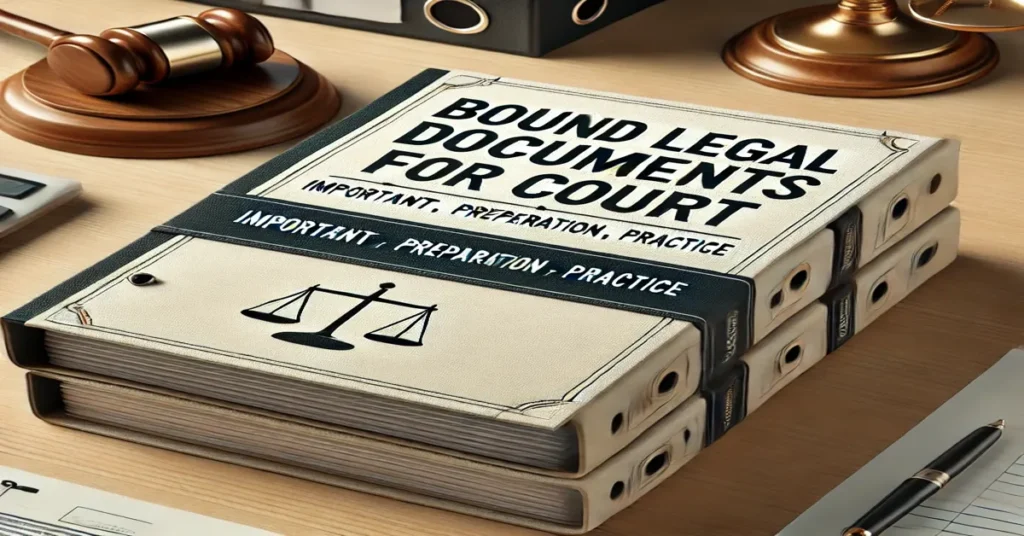Legal proceedings often require the submission of bound legal documents that are organized, professional, and easy to navigate. Whether you’re an attorney, paralegal, or individual representing yourself in court, properly prepared and bound legal documents can make a significant impact on the outcome of a case. Courts rely on these submissions to evaluate evidence, review arguments, and make informed decisions.
This comprehensive guide explores the importance of bound legal documents for court, how to prepare them, the materials and tools required, and best practices for presentation. By the end of this article, you’ll understand how to effectively prepare your legal documents for court submission and ensure they meet all required standards.
Table of Contents
- What Are Bound Legal Documents?
- Why Binding Legal Documents is Essential for Court
- Types of Legal Documents That May Require Binding
- Court Requirements and Rules for Binding Documents
- How to Prepare Legal Documents for Binding
- Materials and Tools for Binding Legal Documents
- Tips for Organizing and Formatting Legal Documents
- Binding Methods: Pros and Cons
- Common Mistakes to Avoid
- Conclusion
- FAQs
1. What Are Bound Legal Documents?
Bound legal documents are collections of legal papers or pleadings that are physically secured together in a book-like format, typically for submission in court. These documents can include case summaries, evidence, affidavits, exhibits, and supporting legal arguments. Binding ensures that the documents remain intact, are easily navigable, and present a professional appearance.
Binding methods vary, but the most common types include spiral binding, comb binding, and thermal binding. Each method provides durability and organization, making it easier for judges, attorneys, and other parties to reference the materials during court proceedings.
2. Why Binding Legal Documents is Essential for Court
Binding legal documents isn’t just about aesthetics—it serves several critical purposes:
1. Organization
Court cases often involve large volumes of paperwork. Binding keeps documents in order, preventing pages from being misplaced or lost.
2. Professional Appearance
Bound documents convey professionalism and respect for the court. Properly formatted and bound submissions reflect the seriousness and preparation of the submitting party.
3. Durability
Court proceedings can take weeks or months. Binding ensures that documents remain intact throughout the case, even with frequent handling.
4. Easy Navigation
Bound documents allow for the inclusion of tabs, dividers, and page numbers, enabling judges and attorneys to quickly locate specific sections.
5. Compliance
Many courts have specific rules requiring legal documents to be bound in a certain way. Failure to comply with these requirements can lead to rejection or delays.
3. Types of Legal Documents That May Require Binding
The types of legal documents that may require binding depend on the case and jurisdiction. Common examples include:
1. Case Briefs
Summaries of a case, including legal arguments and relevant case law, often require binding for clarity and organization.
2. Affidavits
Sworn statements submitted as evidence may need to be bound with supporting documents and exhibits.
3. Pleadings
Legal documents filed by parties to a lawsuit, such as complaints, answers, and motions, are often bound to ensure they stay intact.
4. Exhibits
Supporting evidence, such as contracts, photographs, or charts, is frequently bound with labels and descriptions for easy reference.
5. Appellate Briefs
In appellate courts, bound briefs are a standard requirement, with strict rules governing their format and binding style.
6. Discovery Materials
Documents produced during the discovery phase may need to be bound for submission during hearings or trials.
4. Court Requirements and Rules for Binding Documents
Different courts have specific rules regarding how legal documents should be prepared and bound. It is essential to review these rules carefully before submission. Common requirements include:
1. Page Margins and Spacing
Courts often specify margin sizes (e.g., 1 inch on all sides) and line spacing (e.g., double-spaced text) to ensure readability.
2. Paper Size and Weight
Most courts require documents to be printed on standard 8.5 x 11-inch paper, with a specific weight (e.g., 20-24 lb paper).
3. Font and Size
Commonly accepted fonts include Times New Roman or Arial, with a font size of 12 points.
4. Binding Style
Courts may require specific binding methods, such as spiral binding or stapling, and prohibit others, like loose-leaf documents.
5. Table of Contents
For lengthy submissions, a table of contents with page numbers is often mandatory.
6. Number of Copies
Courts may require multiple bound copies for the judge, opposing counsel, and the court clerk.
5. How to Prepare Legal Documents for Binding
Step 1: Organize Your Content
Ensure all pages are in the correct order and remove duplicates. Include a table of contents for long documents.
Step 2: Proofread
Double-check for spelling errors, missing information, or formatting inconsistencies. Courts expect error-free submissions.
Step 3: Print and Collate
Print your documents on high-quality paper and arrange them in the correct sequence.
Step 4: Add Tabs and Dividers
For complex submissions, use tabs or dividers to separate sections and make navigation easier.
Step 5: Bind the Documents
Choose a binding method that complies with court rules and enhances the document’s durability and appearance.
6. Materials and Tools for Binding Legal Documents
The materials and tools required for binding depend on the chosen method. Common supplies include:
1. Binding Machines
- Comb Binding Machine: Uses plastic combs to bind documents.
- Spiral Binding Machine: Uses coils for a durable and professional look.
- Thermal Binding Machine: Uses heat to bind pages into a pre-glued cover.
2. Binding Covers
Transparent plastic covers and sturdy back covers provide protection and a professional finish.
3. Tabs and Dividers
Use labeled tabs to separate sections for easy navigation.
4. Hole Punch
A three-hole punch is essential for binding methods that use combs or spirals.
7. Tips for Organizing and Formatting Legal Documents
1. Follow Court Rules
Always adhere to the specific formatting and binding requirements set by the court.
2. Use Clear Headings
Headings and subheadings help readers quickly locate information.
3. Number Pages
Include page numbers on every page to ensure easy navigation.
4. Proofread Thoroughly
Errors in legal documents can undermine your credibility and delay the case.
5. Use Quality Paper
Invest in high-quality, durable paper that can withstand frequent handling.
8. Binding Methods: Pros and Cons
Different binding methods have their advantages and disadvantages:
1. Spiral Binding
- Pros: Durable, professional appearance, allows pages to lay flat.
- Cons: More expensive than other methods.
2. Comb Binding
- Pros: Affordable, easy to add or remove pages.
- Cons: Less durable than spiral binding.
3. Thermal Binding
- Pros: Sleek and formal appearance, ideal for appellate briefs.
- Cons: Permanent binding makes page removal impossible.
4. Stapling
- Pros: Simple and cost-effective.
- Cons: Not suitable for lengthy documents.
9. Common Mistakes to Avoid
1. Ignoring Court Rules
Failure to comply with court requirements can lead to rejection or delays.
2. Poor Formatting
Cluttered or inconsistent formatting makes documents difficult to read.
3. Using Low-Quality Materials
Cheap paper or weak binding methods may result in damaged documents.
4. Overlooking Proofreading
Errors in legal documents can harm your case and diminish your professionalism.
10. Conclusion
Bound legal documents play a vital role in court proceedings, ensuring organization, professionalism, and compliance with court rules. By understanding the requirements and best practices, you can prepare submissions that are both effective and visually appealing.
Whether you’re a legal professional or an individual representing yourself, investing time and effort into binding legal documents properly can make a significant difference in your case’s presentation and outcome.
FAQs
1. Why do courts require legal documents to be bound?
Courts require binding to ensure documents are organized, professional, and easy to navigate, preventing pages from being lost or misplaced.
2. What is the best binding method for legal documents?
The best binding method depends on the court’s requirements and document length. Spiral and thermal binding are common choices for professionalism and durability.
3. Can I bind legal documents myself?
Yes, with the right tools and materials, you can bind legal documents yourself. However, ensure they meet court standards.
4. Are there specific rules for binding documents in appellate courts?
Yes, appellate courts often have strict requirements for binding, including page margins, font size, and binding style. Check the court’s rules before submission.
5. How many copies of bound legal documents are typically required?
The number of copies depends on the court and case. Typically, multiple copies are needed for the judge, opposing counsel, and court clerk.
6. What materials should I use for binding legal documents?
Use high-quality paper, binding covers, and durable binding materials like spiral coils or thermal binding covers for a professional finish.







